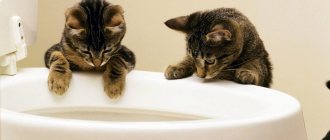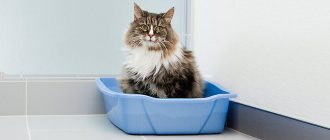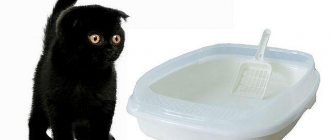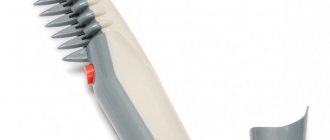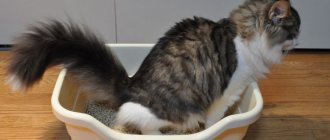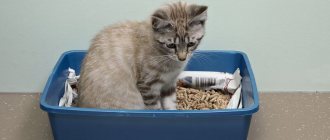Save the article:
The toilet is an urgent natural need of a living animal, and the owner’s task will not be to let everything take its course, but to seriously think about how to accustom the kitten to the litter box .
The vast majority of cats easily adapt to the litter box, although there are some that are particularly stubborn. That is why you need to quickly accustom the kitten to the tray, before the baby decides to please the owner with marked things in the house.
In any case, you need to correctly and seriously approach this fairly easily resolved issue. Of course, it happens that a kitten was taught to use the toilet by its previous owners - in this case, the new owner simply purchases a tray and litter.
global $ads_google; //data-ad-slot=”2475549904″ $ads_google = empty($ads_google) ? false : true; ?> if ($ads_google == false) {?>
$ads_google = true; ?> } ?>
The article provides recommendations and tips for litter box training kittens, following which the problem will be solved quickly and forever.
Age matters, where to start?
The age of the animal plays an important role in litter training.
The age of the animal plays an important role in litter training.
An adult has developed habits (especially if the cat is picked up from the street or purchased from breeders who release pets onto the street). The best age to train a kitten to use a litter tray is between 3 and 8 months.
Younger kittens, especially if they have been weaned from their mother cat, do not yet have a complete picture and understanding of the world around them. Once in a new apartment with the owner, the kids experience a lot of stress, for this reason they cannot immediately get accustomed to the tray.
The process of training a kitten to use a litter tray consists of the following steps:
- Choose a tray or other container.
- Select the type of filler.
- Choose a convenient place where the owner and the animal will not interfere with each other.
How to choose a tray
The best age for training a kitten to use a litter box is from 3 to 8 months.
When choosing a litter box, several important points are taken into account:
- The size of the pot and the kitten must be matched so that the animal can fit completely into the tray after 3-5 months.
- Product material . The container should be smooth; pots with a rough surface absorb the smell of urine more strongly, as they are difficult to wash. Hard plastic is better, which is difficult to break if the cat sits on its edge.
- The color of the tray should be neutral and not too bright so as not to scare away the animal. It is better to opt for pastel or warm colors.
- No defects . There should be no sharp edges or low sides through which the filler will spill.
- No pungent odor , as foreign odors have a negative impact on the kitten’s training in the litter box.
Some owners select other containers from available materials, but they do not always comply with safety rules for the animal.
Manufacturers of cat litter have developed many interesting models . You can find products not only in the form of an ordinary rectangular plastic tray with or without mesh.
Be sure to read:
When kittens start going to the toilet, how to understand that the kitten wants to go to the toilet
Nowadays they make special dry toilets for cats with a filtration system, ventilation or replaceable film. They even make separate closed houses with a toilet (like a tray in a locker), but they are not suitable for all kittens, because some pets are afraid.
Acts of bowel movements and urination at different ages
A healthy kitten visits the restroom often. The health of the kitten depends on the number of visits, so it is important for a loving owner to monitor the rhythm of visiting the toilet. It is also important to find out what measures should be taken if the kitten “keeps everything to himself.”
Newborn kittens
In the first 3 weeks after birth, the mother cat helps her kittens with going to the toilet. By licking them according to the call of instincts, she cleanses babies of dirt, bad odors and activates blood circulation in the digestive organs. Massaging the mother cat helps the kittens get rid of gas and “do their job” - defecate.
If there is no mother cat nearby, the owners become responsible to the kitten. They should stroke the baby every 2 hours before and after meals.
A tiny kitten may refuse to defecate. Gases accumulate in a bloated tummy, and certain manipulations will help eliminate them:
- the owner takes cotton wool;
- wets it in water at room temperature;
- massages the baby's tummy clockwise with it.
Period
By the 3rd week after birth, the kitten is ready to accept more adult food: its intestines are formed and have beneficial microflora. Even if the baby is still feeding on mother cat's milk, you can start introducing liquid food into his diet. At the 3rd week, the reflex of urination and defecation has already been formed, so the kitten goes to the toilet every 4-6 times a day.
Normal bowel movements:
- mushy appearance;
- uniform and thick;
- do not have impurities (for example, undigested pieces of food).
The kitten is energetic and perky. If the stool is liquid or very dry, this is a reason to think about visiting a veterinarian.
You can try massaging in a circular motion. Since there is no mother nearby, responsibility for the baby’s health falls on the owners.
Adults
From 1 to 3 months, the kitten can already switch to adult food. During this period, you should no longer be afraid if the feces are hard - that’s how it should be. The consistency of stool and the regularity of going to the toilet during this period is an individual matter.
A kitten eating food with a high fiber content goes to the toilet more often.
Grown-up kittens go to the toilet regularly and the feces of a healthy pet should not contain undigested food or strange mucus.
Which filler to take
Modern manufacturers make many types of fillers from natural and artificial materials that absorb moisture well and eliminate odors.
Manufacturers of cat litter have developed many interesting models.
Of course, in order to save money, you can buy regular sand at a hardware store, but it will remain on the kitten’s paws and spread throughout the apartment, and it will not get rid of the unpleasant smell of cat feces.
What types of filler are there:
- Clumping filler is made from fine bentonite clay, which forms a lump when interacting with moisture. It is easy to remove and economical to use.
- Absorbent fillers are made from clay, which is processed by drying, pressing and granulation. The downside of clay is that it sticks to the animal's paws. The kitten will try to clean it from its paws, so there is a possibility of swallowing it and subsequent poisoning of the animal.
- Pressed wood is made from sawdust from coniferous trees. This option is the most environmentally friendly and will not harm the kitten. The disadvantage of wood filler is that it disintegrates when exposed to moisture and is difficult to remove from the tray.
- Silico-helium composition is the most economical option, although its cost is higher than others. It eliminates odor well and quickly absorbs moisture. It is produced on the basis of silicic acid hydrosols. The balls made from them do not change their structure and do not crumble when feces enter them. Silica gel changes color, thereby allowing you to determine when it is time to change it.
- Natural materials (cellulose, grain) are an environmentally friendly and cheap option; they hardly stick to the kitten’s paws.
- Mineral compositions are made from processed volcanic minerals; such granules quickly absorb moisture and odors for a long time.
Advice! For adult animals, any type of filler is suitable, but for small kittens who like to taste everything, it is better to choose a natural one.
Choosing a tray for your baby
Half the success lies in buying a convenient tray and a good filler. If they don’t scare the kitten away and he likes them, the baby will get used to correct urination very quickly.
Convenient tray
The first step is to choose a tray. Pet stores offer a wide range of litter boxes for cats, differing in color and shape. The most common are simple plastic containers.
When choosing, pay attention to the following parameters:
- material – usually plastic;
- design;
- size, especially the height of the sides;
- the need to use filler;
- price;
- ease of cleaning for you and comfort of use for the animal.
Almost all cat litter is made of plastic. When purchasing, you need to make sure that the product does not emit an unpleasant chemical odor, since cats have a very keen sense of smell. A sharp unpleasant odor will discourage the animal from approaching the tray.
If your pet is quite timid, you should take a closer look at closed toilet houses, where the baby will not be distracted by extraneous sounds and bright lights - then he will get used to the tray quickly. A significant drawback of the house is that due to its design, it is not always clear whether cleaning is required or not, and it takes up a lot of space.
If you plan to frequently replace your cat's litter box with a new one for hygienic purposes, then for the first time you can buy a small tray that takes up a small area. If you are planning a long-term purchase, purchase a toilet of sufficient size so that the older animal does not feel cramped in it.
Open litter boxes are very easy to clean, especially if they are filled with cat litter. You just need to take a special scoop, take out the soiled mixture and add fresh mixture in its place. A closed toilet is much more difficult to clean. To do this, you will have to disassemble it and thoroughly rinse all the corners where the filler may accumulate and compact.
Several years ago, a new product appeared on the pet products market - dry toilets for cats. This is a real breakthrough in technology: just imagine, you don’t need to change the tray! The dry closet is equipped with carbon filters that need to be replaced every few months, without the risk of an unpleasant odor.
The most luxurious option is a self-cleaning device that connects to the sewer and is essentially a mini toilet for a cat. The difference from a human one is in size and in the fact that the flush operates automatically, no buttons need to be pressed. The sensors themselves determine when the cat went to the toilet and clean the container from excrement. The only negative about such luxury is the exorbitant price, which exceeds 30 thousand rubles.
Suitable filler
You should immediately decide whether you will use the filler. Some kittens are afraid of the granules in the tray or chew on them; such animals are suitable for toilets with mesh. True, many owners do not like them because of the need to thoroughly wash them several times a day. If you neglect this simple rule, the spread of an unpleasant odor throughout the apartment is guaranteed. Some animals, on the contrary, will not approach the tray without filler.
Some owners use river sand or newspapers, but the former instantly drags across the floor on the pet’s paws, and the latter can cause poisoning, since the lead in printing ink is very toxic. A high-quality filler must meet the following requirements:
- quickly eliminate and block odor;
- do not contain dust;
- absorb all the liquid;
- do not stick to the fur and paws of a small kitten;
- have no toxic properties;
- inexpensive.
Based on the principle of operation, cat litters are divided into absorbent and clumping. The first type is more convenient for pets, as it instantly absorbs all moisture. Owners prefer clumping types of filler. Some manufacturers add special indicators that change the color of the mixture depending on the composition of the urine, which helps to recognize diseases of the urinary system in the early stages and contact a veterinarian in time.
Based on their composition, all fillers can be divided into:
- clay, containing bentonite and clay, with a clear drawback in the form of a large amount of dust;
- wood, consisting of small, tightly compressed sawdust;
- silica gel, characterized by high porosity and absorbency;
- corn, which are products of processing corn cobs;
- paper, made by pressing paper;
- coal, they perfectly absorb unpleasant odors in the apartment.
For kittens, it is better to purchase fillers with a natural composition: even if a curious baby swallows a granule, he will not be poisoned. To begin with, purchase wood or paper litter, and then, when the kitten grows up, gradually change it to silica gel or pebbles - if it is convenient for you.
If your pet refuses to use the litter, be a little persistent. It is necessary to accustom the kitten to a toilet with litter, since otherwise an unpleasant odor will accumulate in the apartment, and the potty itself will have to be washed after each toilet. This is very inconvenient and unhygienic.
Where to put the tray to quickly train a kitten?
The tray is placed in a remote area from the kitten’s feeding area so that the smells do not mix. It is better to choose a corridor, balcony, toilet or bathroom for the cat litter, it depends on the interior and the desires of the owner.
It should be easy for the animal to reach the tray at any time of the day without assistance, so it is better to choose a room where there are no doors or where they are easy to open.
Be sure to read:
Causes and treatment of constipation in cats, how to help a cat go to the toilet in a big way
You need to immediately determine the only place for the cat’s toilet; you should not rearrange it, as this will negatively affect the kitten’s training in the litter box.
Is it possible to train a baby to use the toilet of another cat?
Smell is the main safety criterion for cats. The kitten will not use someone else's potty. In this case, even neutral flavors will not help accustom the cat to the litter box.
In order for the baby to learn to use a device that has already been used, the tray must be disinfected and make sure that foreign odors have disappeared.
The process of training a kitten to the tray
The training process can be completed in 1 day, but more often it takes 1-2 weeks. It should be trained on the first day after the animal has sniffed all the rooms of the new house.
Stage one - getting to know each other
When the kitten has become familiar with the room, tried food from the new dishes, and has chosen a sleeping place, it should be taken to the tray and placed in it.
If a kitten jumps out of the toilet, then you should be patient; there is no need to forcibly hold it or scare it. Try repeating the procedure later; it is best to catch the kitten when it begins to spin intensively and look for a place.
Stage two – we observe and help
It is better to plan the process of acquiring and training a kitten on a day off, when the owner will devote all his time to the pet, so that you can observe his reaction and help him get used to it. A small kitten will not be able to endure without a toilet for long.
It is better to plan the process of acquiring and training a kitten on a weekend
He will start looking for a place, fussing, it is important not to miss such a moment, catch the animal and take it to the tray. Do not use force while holding it. It is enough to protect the baby with your hands and not let him go, after 3-5 minutes. need will force him to go to the litter box. After this, you can praise the kitten, caress it, and give it a treat.
If the first meeting was unsuccessful, the kitten defecated in the wrong place, then the pet should be brought to the bowel movement and wagged with a finger, slightly raising the voice, but not hit or “poked” with its nose. After this, transfer the feces to the tray and show it to the kitten. Praise if the animal begins to bury it with litter.
The feces are left until the next time so that the animal can find the tray by its smell.
Stage three - fixing it
Not every kitten can understand the first time where to go to defecate. To do this, you will have to show him the place several times and praise him for the correct actions each time.
The places where “unauthorized piles” were found are washed with a disinfectant (bleach, toilet detergent, soda and vinegar). To consolidate the effect, you can spray the tray with a special spray that attracts the kitten.
A kitten walks by - what to do?
Sometimes there come moments when the owner gives up - the kitten diligently avoids his potty, doing all his business in absolutely inappropriate places. The best solution in this situation is to try to find the cause in order to fix the problem.
Misses
If a small pet constantly walks near the tray, it is definitely uncomfortable for him. The cat simply cannot fit comfortably in it - although he understands perfectly well that the toilet space is here.
Very small kittens do not have time to run or sit up straight - that’s why the mistake occurs. Under no circumstances should you scold for this - it’s better to make the cat as comfortable as possible. As soon as he grows up, the mistakes will stop.
Even if the kitten goes to the litter box regularly, a “failure” may occur in the process. Navigation did not work after too active play or there were strange strong odors in the house - there are many reasons.
If your baby has a bad luck and misses a spot, the most effective way to correct the situation is to blot the puddle with a dry cloth and immediately wash the spot. There is no need to use chemicals: it is better to drop a drop of citrus oil into this place or wipe with lemon or orange peel.
A napkin with the remains of the misunderstanding can be placed in the tray for a while so that the smell remains longer, attracting the kitten to go to the right place next time.
Ignores tray
The first thing you should pay attention to is the cleanliness of the tray. Some cats are so clean that they flatly refuse to go into used litter. Of course, there is no need to completely change the mixture, but all raw elements should be removed.
Another reason could be a strong-smelling product used to clean the cat's litter. Perhaps this smell scares the baby away. Check whether there is free access to the room where the baby's potty is located.
It may also be that the kitten does not like the shape, size or height of the sides of the cat litter. In order to determine this, it is worth observing your pet - if he climbs into the tray, spins around, digs a hole, and then jumps out of it, you should try changing the tray.
In addition to a plastic product, the type of filler you choose may not be suitable for your baby, its texture, or the size of the granules may be inconvenient to walk on. It is impossible to accustom a kitten to a litter that the kitten does not like. It often happens that the owner chooses a scented litter to hide the unpleasant odor, but the animal categorically does not like it.
Sometimes walking outside the litter box is caused by serious problems related to the pet's health. If the act of urination or defecation causes discomfort and pain to the kitten, it will intuitively avoid this process and everything associated with it. In the end, the baby cannot stand it any longer and does his business in the first place he comes across. If blood appears in the urine or feces, the animal meows pitifully and behaves unnaturally, you should immediately go to the veterinary clinic.
Another reason for potty refusal can be severe stress. The baby has settled into his new home, eats well, gets along with everyone in the household, and goes to the litter box. But a strong fear can ruin everything. The reason is a sudden renovation or rearrangement, noisy guests, especially children, another animal in the house.
A kitten ignores the litter box, how to train it?
Unfortunately, not all kittens are obedient, especially those under 6 months of age. It happens that the animal has a character and does not want to perform the actions shown by the owner.
In such cases, you need to use small tricks:
- Use special household chemicals for cat litter.
- If the pet goes to the same corner, but not to the litter box, then the toilet should be temporarily moved for 3-5 days to a latrine, then gradually moved away and moved to a place convenient for the owner.
Sometimes a problem arises that the kitten sits on the tray incorrectly and feces end up on the floor. In this case, it is better to change the tray or rearrange it on the other side.
Determining a place for the cat litter box
For some reason, the first thing new kitten owners try to do is put the container in the toilet room. This is a common mistake. First, the kitten should be denied access to other rooms; it will be enough for him to study the place where the bowl, house, scratching post and the owner himself are located. It is in this room that the cat litter box is temporarily placed. It’s just that the baby may not make it to the distant adult toilet.
In the future, the cat will study the neighboring rooms, move around the apartment more quickly, and then the tray is gradually brought closer to the toilet. It will be convenient to relieve your needs there, and the place is perhaps the quietest in the house.
Important! At first, place the tray strictly in front of the baby and within his reach.
The proximity of the cat's toilet and feeding area is unacceptable. Cats are clean and will not shit near their own food and drink.
If a kitten needs to be trained to use the litter box quickly, then the toilet should be secluded, without drafts and prying eyes. Of course, the door to the cat's litter box should always be slightly open.
Useful tips on how to train a kitten to use the toilet
Teaching a cat to go to the toilet is an ideal option, but for this the animal must be able to jump to such a height.
Stages of mastering a toilet for a cat:
- Accustom the kitten to the tray by placing it near the toilet.
- As the animal grows, place stable boxes under the cat litter box that will lift the pot up. This procedure is carried out once every 1-2 weeks. If the kitten stops jumping into the tray and walks past it, then you need to lower the tray again and repeat the procedure after 1-2 weeks.
- When the tray is level with the toilet, you need to put the potty in it overnight. Keep an eye on the animal; if the cat relieves itself, you can purchase a special attachment for the toilet and completely remove the tray. When the cat gets used to the nozzle, you need to remove it for several nights in a row, gradually accustoming the animal to the toilet.
This method is quite simple, although it seems incredible. In 1-3 months you can train your cat to use the toilet.
